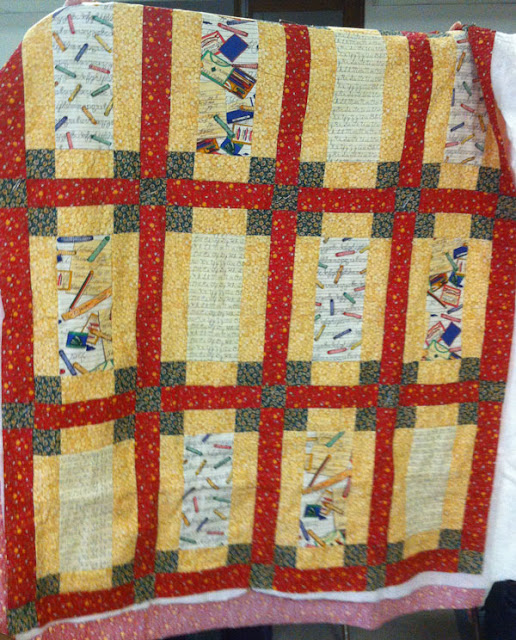Becky and Brenda are shown here with two of Brenda's wonderful quilts.
Ann Ferris brought us a fine example of the piping/binding method that she taught us this evening. The squares are Redwork and the quilt was bound using the Piping Hot Binding method that she learned at a class that she went to, taught by Sue Cleveland. Sue's website is www.Piecesbewithyou.com
Connie Mulliken brought us her Medallion Star quilt.
Becky and Georgia are sharing this beautiful sampler quilt that was pieced by Georgia and quilted by Becky.
I wish I had gotten more of this beautiful quilt into the picture but we sure did catch Georgia with a great smile. Thanks Georgia!
I'm sorry but I don't remember who did this uneven nine patch but it sure is pretty!
This quilt was fused and machine appliqued.
This on was machine embroidered and then machine quilted on a domestic machine.
 |
| Beautiful curvaceous quilt, don't remember who did it. Sorry email me and I will update. |
 |
| This is a close up of the quilt that show the use of the piping hot binding used in the main design of the quilt, it sets off and defines the colors. |
Piping in Quilt Binding
- Layer backing, batting and quilt top. Machine stitch around the edge with a walking foot to prevent the quilt stretching during quilting. Quilt. Do not trim off the excess batting or backing yet.
- Cut enough 2 1/2" wide binding strips to go around the quilt plus about 15". Join them together by sewing diagonal seams.
- Cut enough 11/4" piping strips (on the 45 degree bias) to go around the quilt plus about 15". Join them together by sewing diagonal seams The piping fabric should be a strong contrast to the border and binding.
- Press the piping and binding strips along the length, wrong sides together.
- Steam the cording to pre-shrink it.
- Make the piping. Trim the piping seam allowance to 1/4"
- Apply the piping to the top of the quilt sandwich. Use a bobbin thread that is different from the thread used to stabilize the quilt and contrasts with the quilt backing. Sew directly over the piping stitching line. At the corners allow the piping to run off the edge by about and inch. Be careful not to catch the cording in the stitching.
- Slowly and carefully trim off the extra batting/backing /piping even with the cut edges of the piping.
- Lay the binding over the piping so the tail is about 10" ahead of the corner. pin in place.
- Leave about 8" of loose tail and begin stitching, with the backing facing you, near the corner of the quilt. Stitch one thread to the left of the stitching that attached the piping to the quilt. Stop at the intersection of the piping stitching lines and back-stitch. Remove the quilt from the machine and cut the threads.
- Miter the cornet and continue with the next edge. And so on around the quilt. Stop approximately 10" before reaching the starting point.
- Lay the tails on top of each other so the overlap is 2 3/4". Join Complete attaching the binding.
- Wrap binding to the back of the quilt and stitch in place.
 |
| Patsy sewing her binding on |
 |
| Connie trimming her binding with the special grooved ruler. |
I wish I had more pictures because it really was a good class but I think I got involved in learning the technique and forgot I meant to take pictures.
The dip and cookies were out of this world many thanks Connie. I don't know what you put in those mud cookies but they were sooooo good! What was different? It was my cheat for the week ...... at least till I order pizza Friday night.
Everyone have a great month. Hope to see you all back at guild. Your comments and emails are appreciated. I know I make mistakes so please help me before whoever name that I misspell or quilt that I mislabel sees it! Eeeek!










